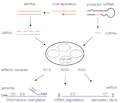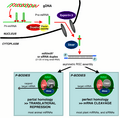RNA interference facts for kids

RNA interference (RNAi) is a natural process inside living cells. It helps control how active their genes are. Think of it as a way cells manage their genes.
In 2006, scientists Andrew Fire and Craig Mello won the Nobel Prize in Physiology and Medicine for discovering RNAi. They found it while studying a tiny worm called Caenorhabditis elegans in 1998.
Two main types of tiny RNA molecules do this job: microRNA (miRNA) and small interfering RNA (siRNA). These small RNAs attach to special messages in the cell called messenger RNA (mRNA). They can either make the mRNA more active or less active. Sometimes, they can even stop an mRNA from making a protein altogether.
RNA interference helps protect cells from unwanted genetic material, like viruses or jumping genes called transposons. It also plays a big role in how living things develop and how gene expression is controlled in general.
The RNAi process is found in many eukaryotes, including animals. Scientists use RNAi a lot in their research, both in cell cultures (cells grown in a lab) and in living organisms. They can put special RNA into cells to turn off specific genes they want to study. This helps them understand how cells work, including things like cell division. RNAi is also becoming a useful tool in biotechnology and medicine.
What RNAi Does
Natural Jobs of RNAi
In nature, RNA interference has a few important jobs:
- It helps cells fight off foreign RNAs, like those from viruses.
- It can increase the activity of certain genes.
- It can decrease the activity of certain genes.
How We Use RNAi
Scientists and doctors can also use RNAi for specific purposes:
- It can be used for gene editing, which means making changes to a cell's DNA.
Images for kids
-
The dicer protein from Giardia intestinalis. This protein helps cut double-stranded RNA into smaller pieces called siRNAs.
-
The folded shape of a pre-microRNA from a plant called Brassica oleracea.
-
How small RNA is made: Primary miRNAs (pri-miRNAs) are created in the cell's nucleus and fold into hairpin shapes. These are then trimmed by a special complex to form a ~60-70nt hairpin pre-RNA. This pre-miRNA moves into the cytoplasm, where Dicer trims it further into a ~20nt miRNA duplex. This duplex then joins with Ago to form the "pre-RISC" complex, and one strand is released to create the active RISC.
-
The enzyme dicer cuts double-stranded RNA to make small interfering RNA or microRNA. These processed RNAs then become part of the RNA-induced silencing complex (RISC). RISC then targets messenger RNA to stop it from making proteins.
-
A normal adult Drosophila fly. These flies are often used in RNAi experiments.
See also
 In Spanish: ARN interferente para niños
In Spanish: ARN interferente para niños







